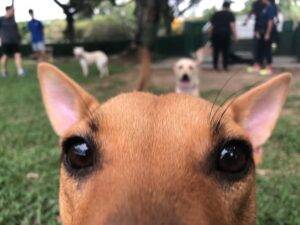
Dog runs are sprouting islandwide and it is a great place to let your dog blow off steam, burn up excess energy and socialise, but just like a child at daycare, some dogs can sometimes be hesitant while another can be overly enthusiastic to enter a dog run. Let your shy dog take all the time necessary, and do some advance preparation yourself to make this transition easier. If your dog is overly excited, drain off some of its energy first and teach it some manners so it learns to greet and play nice.
By picking a dog run with the right conditions, learning about how your dog interacts with other dogs, and knowing what behavioural flags to watch for, you can make your dog’s first visit to the dog run a successful one. A well-trained, socialised dog with no reactivity issues is an ideal candidate for an off-leash experience in a dog run!
Tip 1: Ensure your dog is healthy
Ensure your dog is up-to-date on its vaccinations and parasite control. This includes distemper and kennel cough vaccines as well as flea, tick and intestinal parasite control. Do not bring your dog to the dog run if it is on heat, unwell or has any transmittable skin condition.
Tip 2: A reliable recall is a must
Recall is about more than having your dog come when called. It is also about having a dog that is constantly attuned to you and ready to obey, even in the midst of a game of chase. Recall is about being able to disengage your dog from an activity that is escalating and having it return and stay with you until tension simmers.
Recall skills are important not just for your dog’s safety, but for the safety of every dog it is interacting with. Roughly 50 per cent recall reliability is sufficient enough. Start by practising at home first, which is a calmer and more conducive environment.
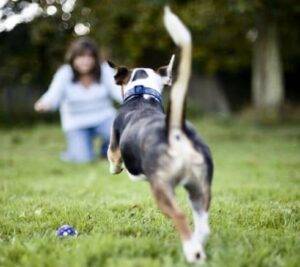
Tip 3: See how your dog behaves while leashed
If your dog is overreactive to dogs while it is on leash, you will have to do some work to make sure it is safe off leash. Barking, pulling, whining, and lunging are all inappropriate ways to respond when your dog sees another dog. It must be non-reactive and calm when it sees or is approached by another dog.
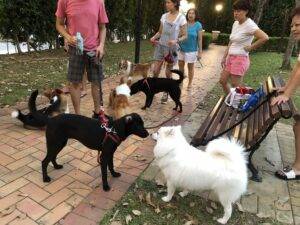
Tip 4: Ensure your dog is calm before entering
When you are ready to enter the dog run, avoid opening the gate if there are a lot of dogs standing there waiting to greet your dog. This is often a tense situation for the incoming dog and fur might fly. If you are faced with a crowd of dogs at the gate, just wait with your dog on the other side until they either begin to disperse, or their owners catch on that your dog needs some space to get comfortably through the gate.
Tip 5: Be alert to the body language of the dogs
When dogs meet, there should not be overexcitement. Just polite and calm greeting. No dog should be made to feel nervous or threatened so be alert to the body language of the dogs. You might think it is cute when your dog is bouncing all over another dog but it is definitely not. Learn when play gestures are socially appropriate to dogs and when they are obnoxious and rude.
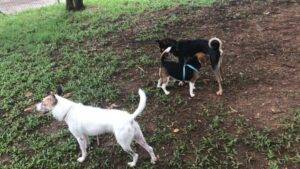
A play bow from a little distance away is cute and so is a tag-and-run request for play. But constantly nipping at another dog’s neck and pouncing on it to wrestle is annoying. Especially when the dog on the receiving end is uncomfortable with it.
If your dog is getting too rough or rude, it is time to call your dog over and have it leave the other dog alone. If you do not do so, you are asking for a fight to happen between the dogs or to get yelled at by the owner of the poor dog being bullied.

Tip 6: Stay off your phone and pay attention
Supervise your dog at all times. Do not get too engrossed talking to other dog owners, or using your phone. Watch that your dog is not stealing toys, competing for treats uninvited or humping legs. You should be engaging your dog and giving it your undivided attention.
Short of that, you should monitor its activities to be sure it is not misbehaving or being intimidated. If your dog is stealing another dog’s ball every time the owner throws it, it is your job to prevent your dog from interrupting their game. And do remember to pick up your dog’s poop!
Tip 7: Do not carry your dog
Be aware that if you pick your dog up, let it sit on your lap, or restrain it in any way (holding the collar or leashing it), your dog is likely to be defensive to approaching dogs. On your lap, it is guarding its resource, i.e. you, and in the other situations, your dog is going to be defensive because it cannot get away. And for people with little dogs, picking your dog up just makes the other dogs want to grab it!
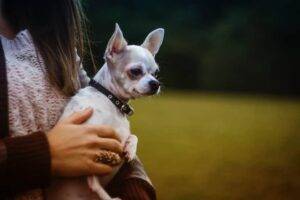
Tip 8: Make sure your dog has other opportunities to exercise
Taking your dog to a dog run for exercise is like taking your child to a playground for exercise. Both are potentially crazy environments with no rules where everyone is running around wildly. It is good to walk your dog first, for at least 10 to 15 minutes, depending on the dog, to make sure it does not go in all pent-up or overzealous.
Tip 9: Reward and praise before you leash up and leave
When it is time to leave, make sure your dog gets a high-value reward and profuse praise so it does not feel punished for coming when called. In your dog’s mind, you are punishing it if you leash up and leave when it comes running to you when you call. Make leaving the dog run as rewarding as visiting it.

Tip 10: Young children, toddlers and babies are a no-no
A child’s smaller size and lack of experience with dogs can create a dangerous situation for both the child and dog. An overexcited dog may unintentionally knock over or injure a child while greeting or playing. A dog who is afraid of children may react aggressively to a child’s attempt to make friends. In rare cases, a dog may even view a child as prey. Regardless of the situation, the risks to the child can be significant.
Last but not least
Training is key to making your trip to the dog run a success and practise makes perfect! Do not be complacent because every dog, no matter how well-trained, needs reminders on how to be a good canine citizen.

(Some of the photos were kindly provided by the owners of dogs that have graduated from our Basic Obedience Group Classes)
